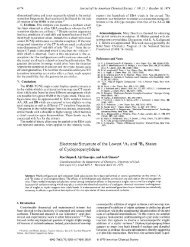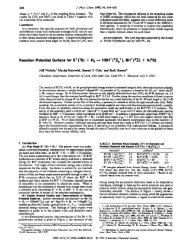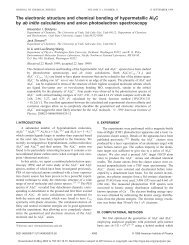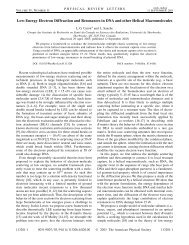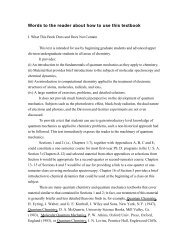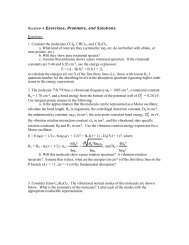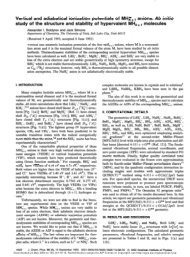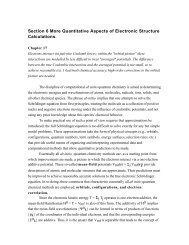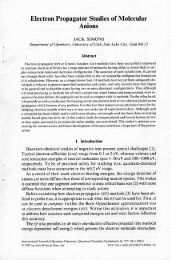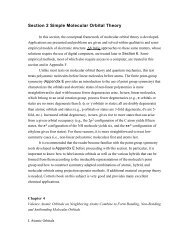First-Order Geometrical Response Equations for State ... - Jack Simons
First-Order Geometrical Response Equations for State ... - Jack Simons
First-Order Geometrical Response Equations for State ... - Jack Simons
Create successful ePaper yourself
Turn your PDF publications into a flip-book with our unique Google optimized e-Paper software.
,,'FIRST-ORDER GEOMETRICAL RESPONSE EQUATIONS 377theorbitalrotations result in a new set of CSF'Sthat is a unitary trans<strong>for</strong>mation ofthe original set of CSF'S.In the case of a complete active space (CAS)calculation,only rotations among core orbitals and valence orbitals, among core orbitals andvirtual orbitaIs, and among valence orbit,als and virtual orbitals are nonredundaRl;that is, in a CASSA-MCSCF calculation with no use of spadal symmetry, if thenumber of core orbit aIs is MCo, the number of valence orbitaIs is MVa, and thenumber of virtual orbit aIs is MVi, the linear set of nonredundant equations representedin Eq. (59) bas the dimension (MCoMVa + MCoMVi + MVaMVi) +(ON) + (0(0 - 1)/2 - ~). .Note that <strong>for</strong> an SAcalculation where all internal states have been assigned different- weighting factors, Eq. (64) vanishes and only Eq. (59) bas to be solved.This situation occurs in the special case where the SA-MCSCF calculation is a usualMCSCFcalculation (Le., in the case where we have oBly one internal stale). In thiscase, the linear response equations in Eq. (59) are similar, but not identical, tothe response equations derived <strong>for</strong> MCSCFwave functions by Osamura et al. [20]and Hoffmann et aj. [19]...The difference' is due to the way we extend the AandBmatrices to the Aand Bmatrices, which is different tram the equivalent extensionmade in Refs. 19 and 20. The most pronounced difference between theresulting sets of equations is that the molecular gradient elements E ~ appear inthe equations of Refs. 19 and 20, ~ut does not appear in the equations derived inthis wark. However, it should be mentioned thatthe molecular gradient elements<strong>for</strong> each interna! stale caD be evaluated if desired, in OUTapproach, tramthe following equation derived tram Eq. (41):E~ = LCf{ LCfHIi - 2 1 LS::nT~J I n+ L 2: [(T~~ - Ti~)U::k ~ Ti~S::k] }'n k




